Dog Nutrition Guide: Feeding Schedules, Portions & Foods to Avoid
One of the most common questions dog owners ask is: “How much should I feed my dog?” The answer isn’t always simple.
In general, the first step is to consult your veterinarian. Feeding amounts depend on your dog’s weight, age, activity level, and breed.
Below, we’ve created a comprehensive nutrition guide, including a dog nutrition chart, to make sure your pup is in peak shape for a lifetime.
How Much to Feed Your Dog
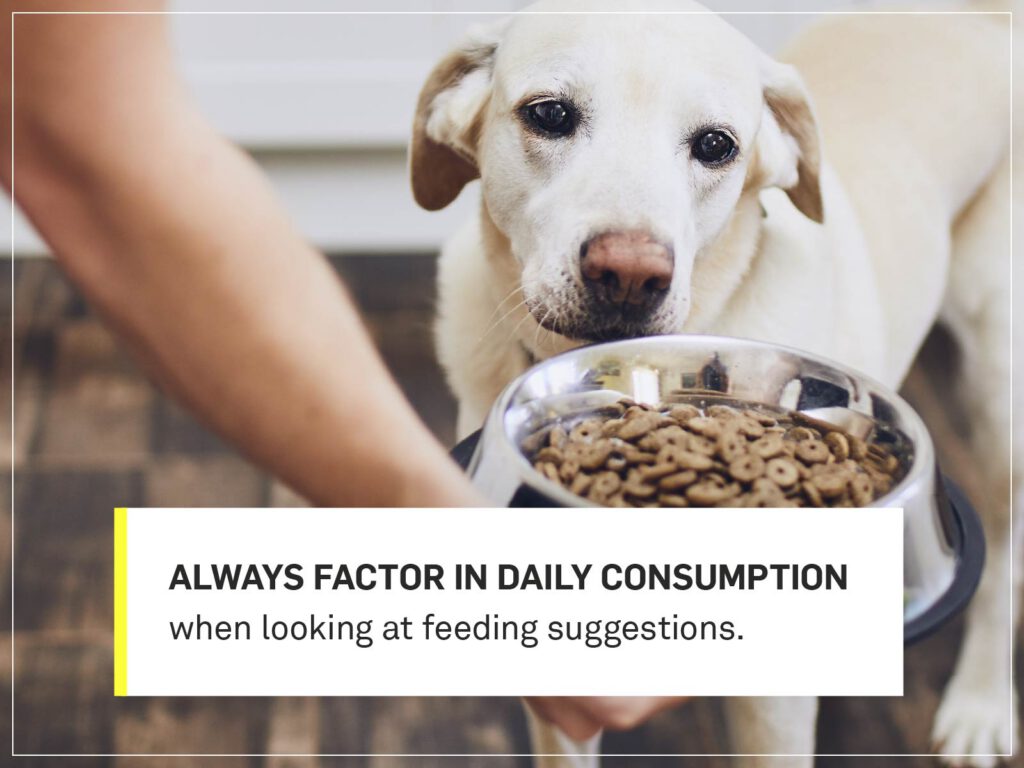
The answer usually comes from a dog feeding chart.
It’s important to remember that most feeding charts list the total daily consumption, not the serving size per meal. This often confuses owners.
Example: If a chart says a 15-pound dog should have 1.5 cups of food per day, that 1.5 cups needs to be divided by the number of meals. If you feed your dog twice daily, that equals ¾ cup per meal.
Always confirm with your veterinarian before changing your dog’s feeding amounts, especially if your dog has special needs like allergies, obesity, or joint problems.
Take a look at the dog nutrition chart below to see how much you should be serving your dog depending on their weight. Remember, always consult your veterinarian before starting or changing your dog’s diet.
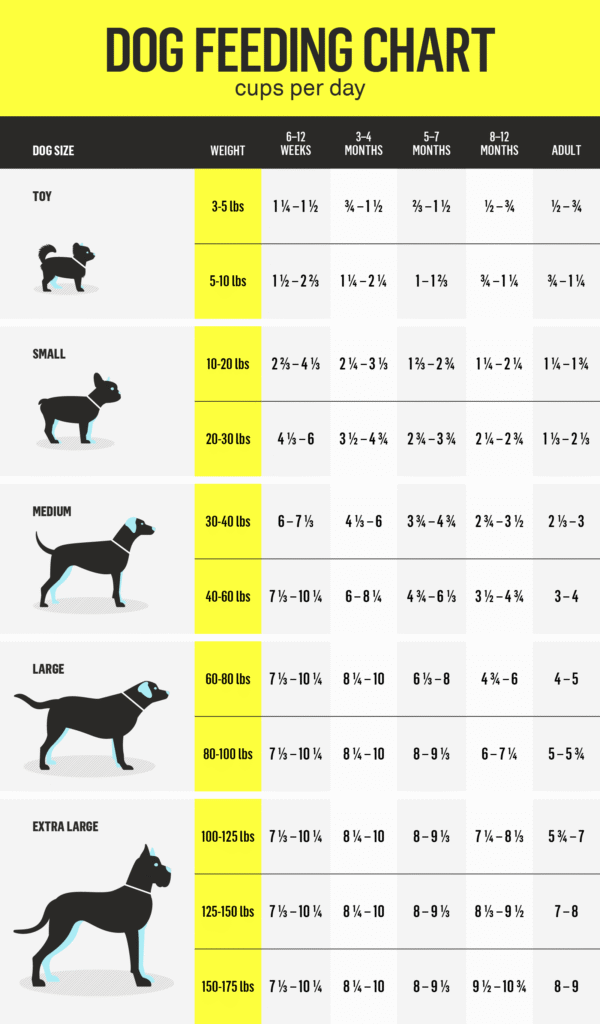
How to Read A Dog Feeding Chart
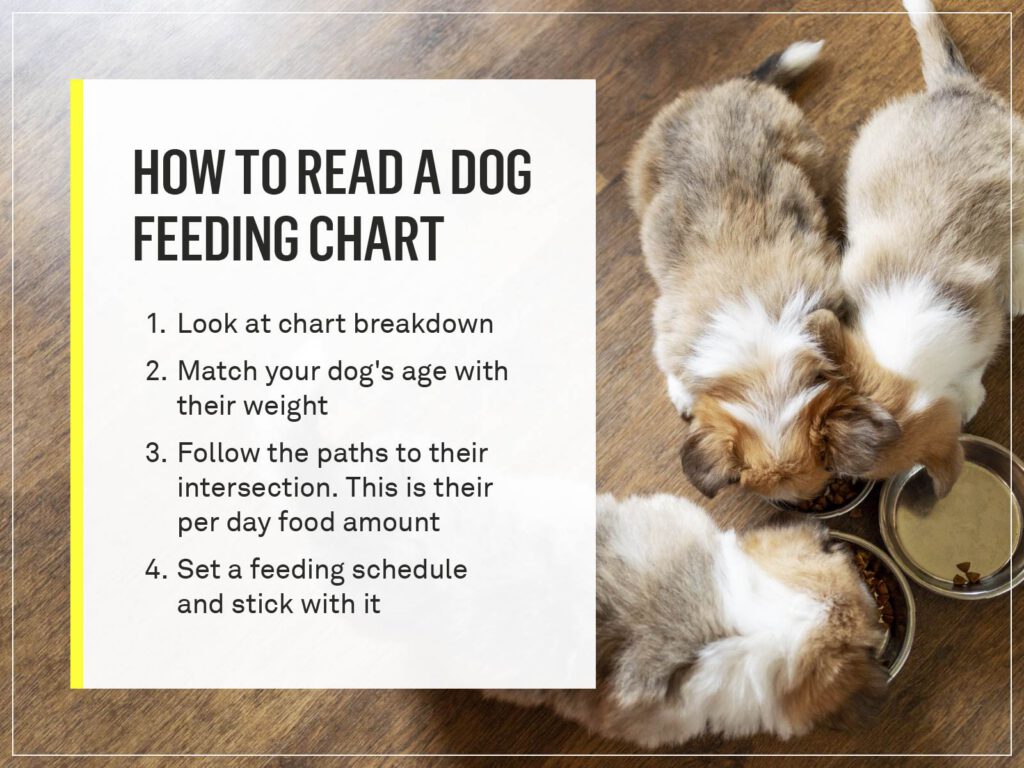
How to use a dog feeding chart? Almost all dog food brands have their own, and each will be slightly different. Overall, though, these charts give you the same information. If you know how to read one, you can usually read them all.
Here’s what to look for:
- Weight vs. Age: Some charts use weigh while others break it down by puppy, adult, or senior life stage.
- Per Day Measurement: Most show the total amount per day. Divide this number by the number of meals you feed.
Schedules are Guidelines: Feeding charts are estimates. If your dog is very active or sedentary, adjust accordingly. And if the feeding schedule on the chart doesn’t match what you usually feed your dog, be cautious about switching and contact a vet.
How Portion Sizes Differ by Breed
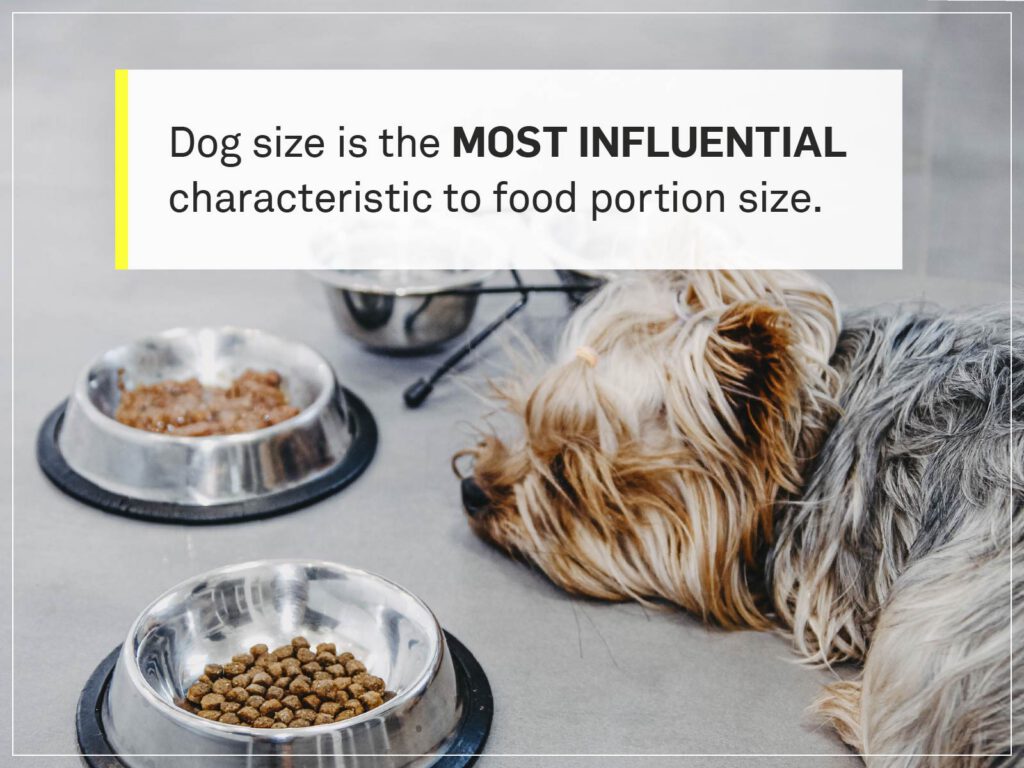
Does breed matter for feeding? No, your dog’s breed won’t have as much of an impact on their dietary needs as their size will. The larger your dog, the more food they will need to eat. A Mastiff needs far more calories than a Pomeranian.
Age is an important factor in determining meal size. For the first year of your pup’s life, portion sizes will go up exponentially from month to month. However, once your dog is an adult (i.e., when they stop growing), their portions will remain the same from year to year. Puppies require more calories per pound than adults. Senior dogs need fewer calories.
How Age Affects Dog Feeding
As a dog gets older, their dietary needs change. Because senior dogs are less rambunctious than their puppy and adult dog counterparts, caloric needs drop significantly. Pay attention to your pup as they get older and ask a vet if you think they’re slowing down.
Puppies:
- Need 3–4 meals per day.
- Require higher calories to support growth.
Adult dogs:
- Do best with 2 meals per day.
- This helps maintain metabolism and prevents hunger.
Senior dogs:
- Need fewer calories since energy levels drop.
- May require special senior dog food formulas recommended by your vet.
If you’re wondering when to switch from puppy food to adult dog food, check out our guide on making the transition safely.
How Often Should You Feed Your Dog
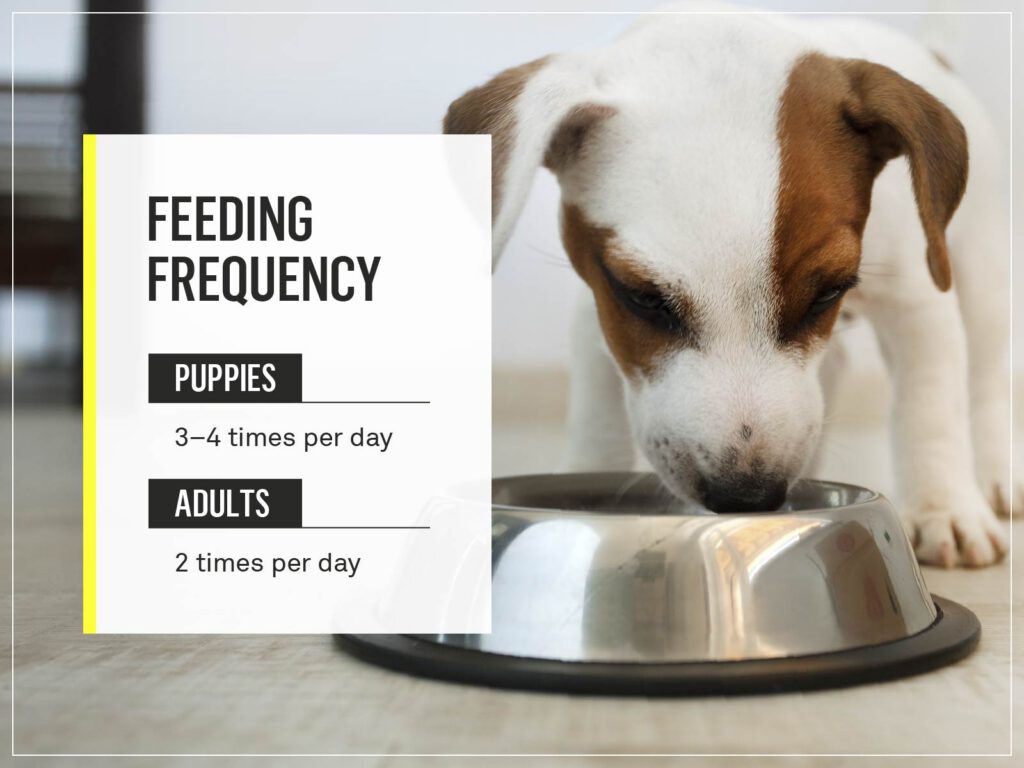
Feeding your dog the proper amount of times per day will make life easier for you and them. Too much food will result in bowel issues and can cause obesity. Too little food will also cause internal problems and can stunt growth.
Adults do best with consistent two meals per day — once in the morning, and once at night. This helps maintain metabolic processes and keeps them from getting hungry.
Puppies should be fed shortly after waking up, every 3–4 hours during the day, and again before bed. Smaller meals are easier for young dogs to digest and will keep their energy level constant throughout the day. This does not mean you should increase caloric intake—divide the appropriate amount of total food by three or four, depending on how many meals you have.
Remember that if you’re going to be feeding them treats during non-meal times, this increases their caloric intake. Don’t forget to count the calories in the treats!
How to Set a Dog Feeding Schedule
Setting a schedule is one of the easiest parts of dog ownership — it just takes repetition!
Steps to set a feeding schedule:
Step 1: Fill the dog bowl with the right portion.
Step 2: Place it in a designated spot for ~5 minutes.
Step 3: If your dog eats, great! If not, remove the food and try again at the next meal.
Within a few days, most dogs adapt.
Some owners try free-choice feeding (leaving food out all day). But many vets strongly advise against it. The chances of your pup becoming overweight are extremely high. Also, behavioral problems around aggression may arise.
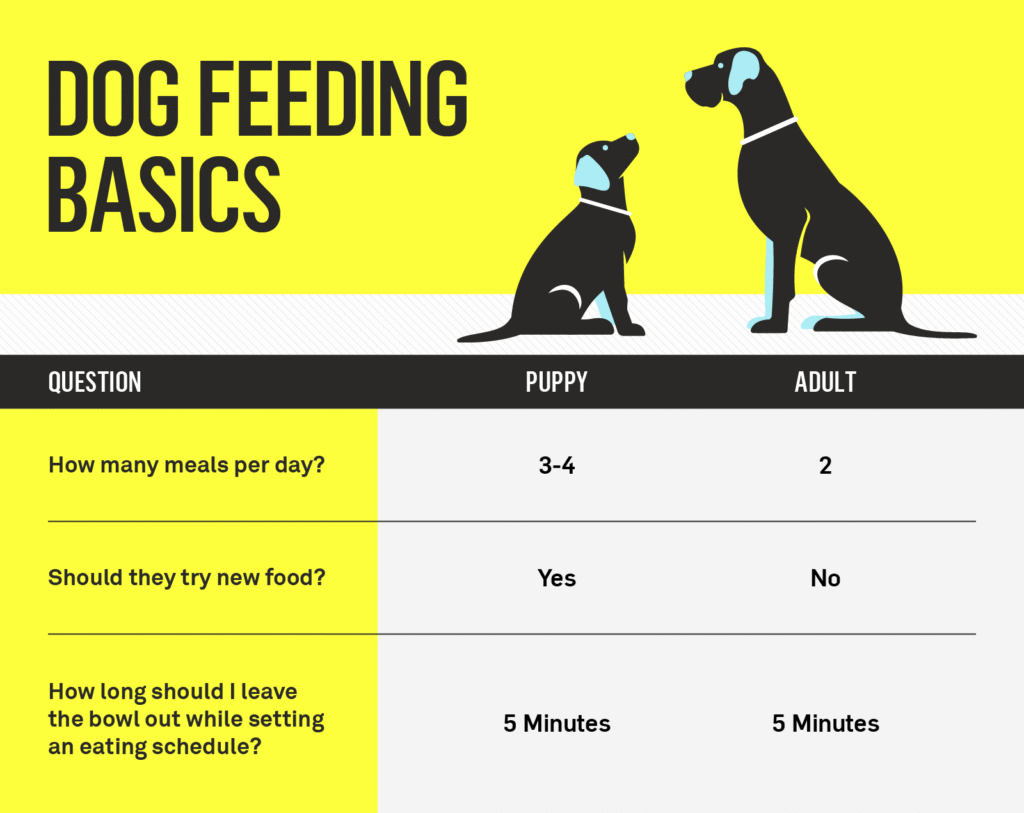
How to Pick a Pet Food
The best way to pick a pet food is by trial and error. There are many different choices out there for dogs to choose from, so as long as the food has healthy ingredients, leave it up to your pup!
Tips for choosing dog food:
- Look for natural ingredients and avoid fillers.
- Ensure it’s AAFCO-approved for complete nutrition.
- Choose formulas made for your dog’s life stage (puppy, adult, senior).
- Ask your vet if your dog needs special diets (sensitive stomach, allergies, weight management).
Foods to Avoid Feeding Your Dog
Some human foods are toxic to dogs. Always avoid feeding dogs:
- Almonds
- Chocolate
- Garlic
- Cinnamon
- Macadamia nuts
- Human ice cream
- Grapes
- Raisins
- Avocado
- Onions
- Alcohol
- Caffeine
- Whole peaches
- Whole plums
- Cooked bones
Tips to Create a Responsible Dog Diet
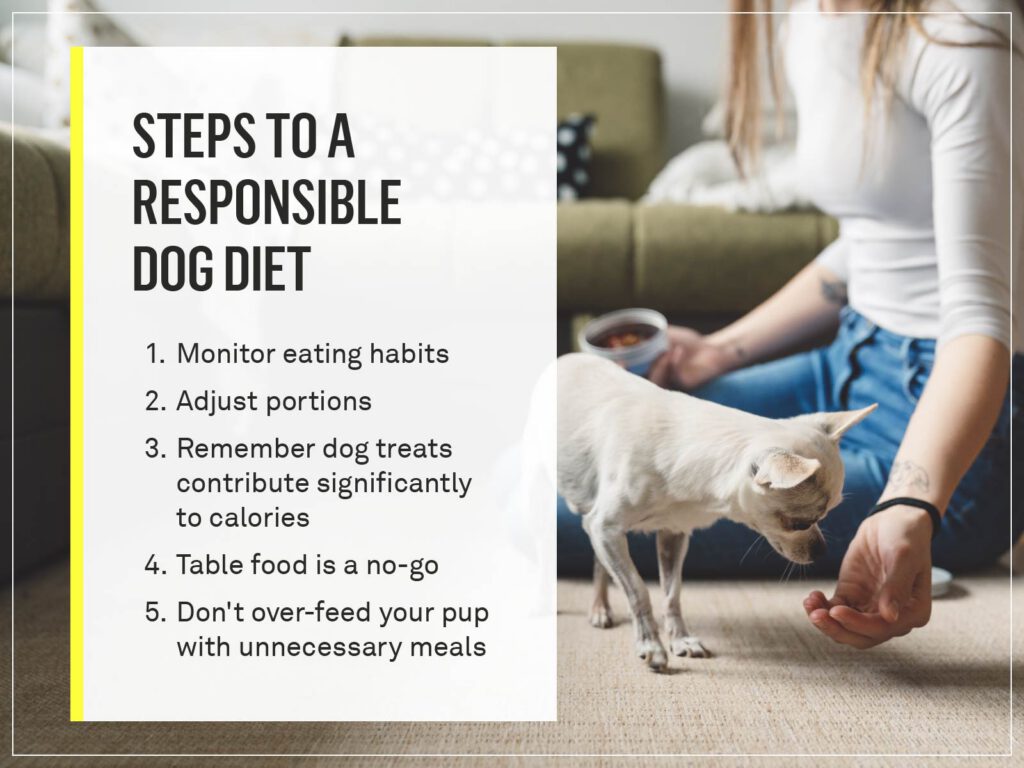
Over time, your dog will develop food preferences, just like people. Building a responsible diet ensures they stay healthy.
5 key tips:
- Monitor eating habits.
Notice which foods your dog enjoys and tolerates best. While some dogs may find natural protein delicious, others may be nauseated by it. Whether your dog is a puppy or older, try different foods—fresh meats and vegetables specifically—to see which they like the most.
- Adjust portions.
If your dog is highly active, they may need more calories. Sedentary dogs need less. Just like with human diets, more calories mean more energy—it just needs to be burned.
This is especially important to remember when adding natural food supplements. Unseasoned cooked steak can be a delectable addition to dry or wet dog food, but you need to account for these calories.
To do this, break the supplemental dish up into small, kibble sized pieces and measure them out. Typically, you can replace normal pet food with these types of additions at a 1:1 ratio. Meaning if you cut up ¼ cup of steak, take out ¼ cup of dog food for the day
- Remember treats
All the snacks your good boy gets boost his daily caloric intake, too. Treats are a necessity when teaching dogs tricks, but keeping an eye on how much you’re feeding a pup is essential. Follow the “10% rule”—treats should account for no more than 10% of daily calories.
- Avoid table scraps
It might be hard to resist those puppy-dog eyes, but sharing food from the table can actually do more harm than good. It teaches your pup that begging works and can sneak in extra calories, leading to weight gain. Many table foods are also high in fat, salt, or spices, which aren’t healthy for dogs.
- Extra food doesn`t mean extra love
Always keep caloric intake in mind when feeding your dog. Overfeeding leads to obesity, joint pain, heart disease, and many other health problems.
Nutrition is important, but it`s only part of the picture. At Gallant, we believe in supporting your pet’s health throughout every stage of life. We are advancing ready-to-use, off-the-shelf stem cell therapies—treatments designed not just to ease symptoms, but to encourage true healing and tissue repair—supporting pets in living healthier, longer lives.
Explore Stem Cell Therapy for Pets
Love learning about your dog’s health? Take the next step and see how regenerative medicine and stem cell therapies are changing care for conditions like arthritis and skin disease.


